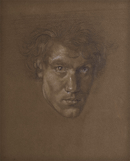But the stream of images and ideas that has flown upwards from it has permeated and powered the dreams and work of many Londoners - Chaucer, Blake, Dickens, Lord Leighton, Beardsely, Eliot. I count some temporary residents amongst that lineage too - Carlyle, Walter Crane, Robert Calvert - even perhaps Syd Barrett for a couple of years before he fell. Unaccountably, one of the almost forgotten is Austin Osman Spare, the Kennington Blake. Like Blake, he was prolific, oscillated between grandiosity and despair and died in penurious obscurity. Why? Unfashionable, difficult, untruthful, yes. Mysterious, obsessive, inspired, definately. A friend for a while of Aleister Crowley, an inventor of his own religious system, a master draughtsman, a mystic, a loner, a fabulist, a war artist, social chronicler. One of the greatest mysteries about him is that he is has been so neglected.
It seems something is changing though - there is an exhibition of his work at The Cuming Museum not far from where he worked in Southwark. And in January, our friends the Strange Attractor Press are publishing "Austin Osman Spare: The Life and Legend of London's Lost Artist" by Phil Baker with a special limited edition. I imagine Spare would be glad of a growing posthumous fame - like Blake he seemed to fear and desire public acceptance. If you have the money and taste for art dealing, it is a good time to buy I think. If you haven't the money but have taste for dreaming,the book and the work is enough.
He was born in Clerkenwell on Snow Hill next to the river Fleet - the physical correalate of London's pyschedelic undercurrent.


7 comments:
Unsurprisingly, I had not heard of Mr. Spare until now, but I am most pleased to make his acquaintance. Thanks so much for introducing him.
Yet another visionary to thank The City for.
May I ask you a question? Why did you pick up these two drawings which are classical self-portraits in a manner while there's a great number of works (and self portraits, too) that are much more impressive (and psychedelic, too) and don't remind one of art school studies? I'm just curious.
You make a good point.
It's true that these self portraits (young and old) are rather conventional and don't hint at the strangeness of some of the other work. But it's difficult to illustrate the latter at a small scale, particularly the books and works with calligraphy. They were chosen to illustrate the man - and the current show at the Cuming museum which largely contains portraits.
Actually for me, Spare the man or Spare the character is perhaps more intriguing than Spare the artist. He made a lot of work: all of it beautifully executed and admirable but much of it conventional - for example his portraits of Southwark locals in which he selected 'character over beauty' in his sitters. Unlike Beardsley or Blake or some of the other artists he was compared to, he didn't seem to have a consistent aesthetic vision.
But his life was fascinating - living alone all those years with his cats and his 'familiars' painting away in a damp basement.
By the way, I doubt you would find many art schools now where such studies would or could be made - at least not in London.
I see your point now, thanks, that makes sense.
Yes, he was fascinating. It seems that with all that magic, mysticism and automatic techniques he still was so perfectly sensible and took such a sober view of things and of himself - a quality which is far from being conventional among artists. Well, not only among artists, but artists in particular.
As for the art schools, well, I'm not quite familiar with the situation in London, what do they do there then? And you still would find plenty of such schools in Russia. For example, these are my first professor's drawings:
http://tinyurl.com/33oaulz
http://tinyurl.com/39ltpk2
And this one's for you:
http://tinyurl.com/35tl2f2
Well, it's rather rough but drawing is not my major.
Wow, that's a lovely drawing.
From my experience in art schools here, only the good ones encourage students trying to gain a basic knowledge of life drawing and even then they often don't focus enough on techniques. Less schooled and more trial and error, under your own steam. And yes, London art schools seem to always be pushing for concept over skill and good practice.
Oh! Thanks so much - that is lovely - and so generous. Much appreciated.
And your teachers drawings - really wonderful actually. the depth of character is enviable.
Yes I think Tamsin's right - drawing is not so fashionable now - in fact it seems to have become actually unfashionable - well in comparison with concepts.
It's interesting that Blake and Spare and the mystical artists generally mastered their craft first -as of course did some of the moderns like Picasso and the great free Jazz improvisers - gave them a kind of depth and discipline somehow I think
Thanks again
Well, I still believe one needs to gain this basic knowledge of life drawing even (and especially) if one plans to discard life drawing throughout one's future work. Thus it will be a kind of more grounded denial. Though there're artists that do perfectly well without it, of course.
Also, it looks like people just tend to think life's too short to learn some techniques when you can go directly to concept. But it's not, we have plenty of time for everything, Spare's life is a good illustration of it.
Post a Comment